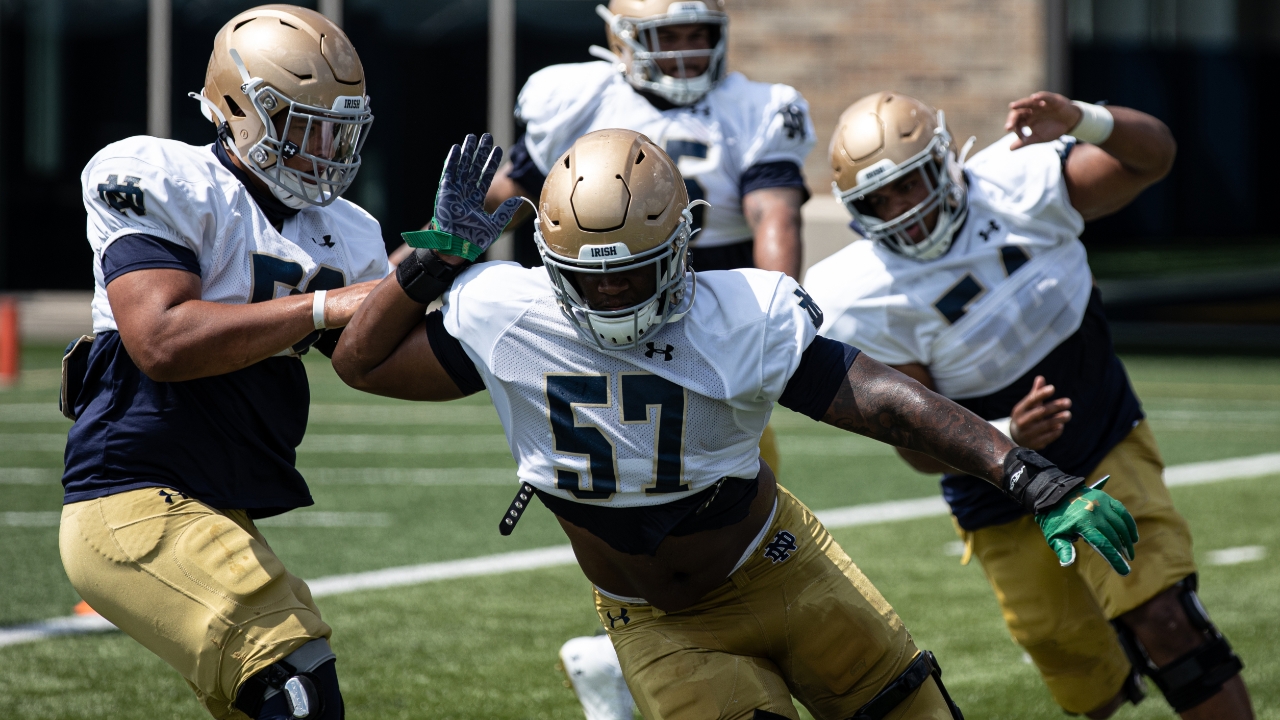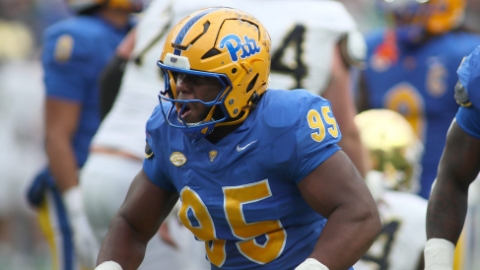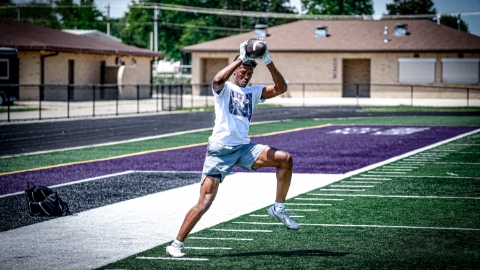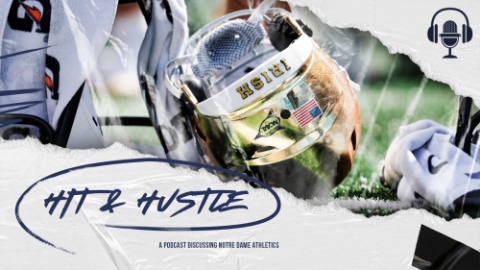
Notre Dame’s defensive tackles combined for 20 Havoc plays last season (tackles for loss, pass breakups, forced fumbles, and interceptions). That’s solid, but not spectacular production.
Sheldon Day had 21.5 on his own in 2015. Now that’s spectacular.
I don’t know about any one individual having that kind of season for the Irish, but don’t be surprised if they have the most disruptive production from a combined effort that we’ve seen in the Brian Kelly era. Even with Myron Tagovailoa-Amosa moving to end, it’s a deep group that looks like they will thrive in Marcus Freeman’s defense because the scheme fits a lot of the strengths of the individuals.
Howard Cross and Jacob Lacey might not be the ideal at nose tackle when it comes to measurables, but both players can get lateral and penetrate into the backfield. Jayson Ademilola, who has very similar traits to Day as a college football player, can do the same.
Kurt Hinish is going to be a disruptive player because of his first step quickness and Rylie Mills demonstrated in the Blue-Gold game that he can win using his length to overwhelm with his bull rush.
Those five players are going to play a lot and I’m not sure there is going to be much drop off no matter who is on the field for Notre Dame. Sometimes that can be a bad thing if everyone is on the same level and eating up space, but that’s not what we’re going to see from them. These are all ascending players and I wouldn’t be surprised to see any of them have the kind of game where they live in the backfield of an opponent.
In 2015, the Irish had Day go off with the most tackles for loss in a season from a Notre Dame player in the last decade. In 2016 Jarron Jones was back healthy and had a game against Miami where he was borderline unblockable. In 2018 it was Jerry Tillery’s turn to be a force with double digit TFLs and a game wrecking performance against Stanford.
No one player at defensive tackle is likely to have that kind of singular impact in 2021 for Notre Dame, but the cumulative performance from the group as a whole has a chance to be pretty special. The competitoin at that spot is only going to fuel the players to keep adding to the total.
2. Competition is good at every position on a football team, but we got to really see the benefits of it at the Vyper position the previous few seasons.
Daelin Hayes was supposed to be the star and entrenched as the starter. Julian Okwara pushed him before eventually becoming the starter and the defensive line having two quality players at the spot. They made the defense better and I think we could be seeing the same thing with Isaiah Foskey and Jordan Botelho.
Foskey is supposed to the next great pass rusher for the Irish and he has flashed in a big way, especially early last season. That starting Vyper spot was meant to be his, but don’t put him down as the starter quite yet. Not after the spring Botelho had where he constantly showed up in highlights wreaking havoc and then punctuated that with a disruptive spring game.
They are going to make each other better if they continue to compete like this and in the end it won’t matter much who is the starter. Both are going to play a ton of reps and opposing offenses will have to deal with them on the field at the same time on 3rd downs.
3. I think many would have thought that Marist Liufau was a lock to start at Will after his finish to last season and Shayne Simon seeing his reps cut significantly.
Marcus Freeman looks like he might have unlocked something in Simon that Notre Dame fans have been waiting years to see (minus the first Clemson game last year). He looked like he was playing faster and more decisive than he ever has in the spring game, which is exactly what has been missing from his game.
The issue with him has never been his athleticism. It’s that he has never played with the confidence or processed things fast enough to take advantage of his athleticism. When this is combined with the things we’re seeing from Liufau as a playmaker, it goes down as another good problem to have for the Irish.
Simon could have easily been in a similar situation to Gibbons if he didn’t have a good spring. Now it looks like he could have a late-career surge like Asmar Bilal.
4. I know he hasn’t been written about very much, but I have to say that there were some flashes from NaNa Osafo-Mensah in the spring game that really intrigued me.
It’s not a natural thing for most pass rusher to control the wrist of an offensive lineman and I saw him do it a few times. That’s something Khalid Kareem could do and do very well.
Originally I thought he might be someone on the outside looking in with the defensive line rotation this year, but seeing that made me rethink that a little bit. There’s some good pieces there and he along with Alex Ehrensberger are two to watch in fall camp.
5. I always look at the true road games when judging how difficult a Notre Dame schedule will be in a given year and it’s not exactly the toughest matchups compared to some other seasons.
The Irish have four true road games: at FSU, at Virginia Tech, at Virginia, and at Stanford.
So a team that is rebuilding in FSU and two programs who recruit at an inferior level to Notre Dame that are 72nd and 77th in returning production are the ACC opponents. The trip to Palo Alto used to be Brian Kelly’s kryptonite, but Stanford also used to be a good program. Where they are right now is TBD.
There’s still a lot of things Notre Dame has to get figured out, especially on offense. All of the ranked opponents they will face will be at home or might-as-well be at home (Wisconsin in Chicago). Kelly hasn’t had too many of these kind of schedules in the last 10 years.
6. Notre Dame signed five top-200 recruits on the offensive line in their 2013 recruiting class. Only two ended up as starters and only one is in the NFL (Mike McGlinchey).
The 2019 class had four 4-star prospects on the offensive line. One transferred out before he finished his second fall camp, one is set to be the starter at center (Zeke Correll), and there are two who, if they were playing a game today, probably aren’t starters (Quinn Carroll and Andrew Kristofic).
I don’t know if Carroll and Kristofic are going to be factors this year or end up as starters at Notre Dame. If they don’t, it won’t be disastrous just like it wasn’t disastrous with the 2013 class. That’s because Notre Dame signed Alex Bars, Sam Mustipher, and Quenton Nelson in the 2014 class.
The 2015 class had Jerry Tillery, Tristen Hoge, and Trevor Ruhland. Despite not working out that well on the offensive side of the ball, they ended up being fine because they signed Liam Eichenberg and Tommy Kraemer in the next class. The class after that one had Robert Hainsey and Aaron Banks.
Of course everyone wants to hit on prospects every year, but the reason why it’s necessary to continue to stack blue-chip prospects in class after class at a position is that a program will likely hit in the next class if they miss in the previous one.
So even if Carroll and Kristofic don’t end up being the players we thought they were, having Tosh Baker, Michael Carmody, Blake Fisher, and Rocco Spindler in the next classes can make up for that.
The lesson is that you can never sign enough top prospects. That’s why Notre Dame has a chance to continue to be “O-line U” even if expectations aren’t met a few years later in a particular recruiting class.



